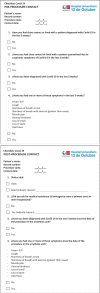Impact of Coronavirus Disease 2019 on Cardiac Arrhythmia Care: Experience of a Spanish Tertiary Hospital During the Health Crisis Triggered by the First Wave of the Pandemic
- PMID: 34595054
- PMCID: PMC8476090
- DOI: 10.19102/icrm.2021.120903
Impact of Coronavirus Disease 2019 on Cardiac Arrhythmia Care: Experience of a Spanish Tertiary Hospital During the Health Crisis Triggered by the First Wave of the Pandemic
Abstract
The coronavirus disease 2019 (COVID-19) pandemic has resulted in a deep restructuring of cardiovascular care, especially in the setting of cardiac arrhythmia units, which are characterized by a wide variety of clinical and interventional activities. We describe the experience of a large university hospital deeply hit during the COVID-19 health crisis (first outbreak of the pandemic), focusing on the exceptional measures implemented and their impact in terms of outcomes. We performed a retrospective study comparing the human and structural resources and the activity of a cardiac arrhythmia unit in a Spanish tertiary hospital for two consecutive periods: from January 12, 2020, to March 8, 2020 ("pre-COVID stage"), and from March 9, 2020, to May 2, 2020 ("COVID stage"). Data were contextualized within the number of confirmed COVID-19 cases in the region of Madrid. The measures implemented were promotion of non-face-to-face consultations, selection of urgent procedures, design of a "COVID-free" circuit for outpatient interventions, and protocolization for patients with COVID-19. A total of 3,526 consultations and 362 procedures were performed. During the COVID stage, the number of consultations remained stable, and the electrophysiology rooms' activity decreased by 55.2% with a relative increase in the number of urgent-hospitalized cases attended (11.8% COVID-19-positive patients). The electrophysiology rooms' activity returned to "normal" in the last week of the COVID stage, with no contagion being detected among patients or professionals. In conclusion, the measures implemented allowed us to respond safely and efficiently to the health care needs of patients with arrhythmias during the COVID-19 crisis and may be useful for other institutions facing similar situations.
Keywords: Arrhythmia unit; COVID-19; cardiac electrophysiology; coronavirus; health management.
Copyright: © 2021 Innovations in Cardiac Rhythm Management.
Conflict of interest statement
The authors report no conflicts of interest for the published content.
Figures





References
-
- Zhou F, Yu T, Du R, et al. Clinical course and risk factors for mortality of adult inpatients with COVID-19 in Wuhan, China: a retrospective cohort study. Lancet. 2020;395(10229):1054–1062. [CrossRef] [PubMed] - DOI - PMC - PubMed
-
- Huang C, Wang Y, Li X, Ren L, Zhao J, Hu Y. Clinical features of patients infected with 2019 novel coronavirus in Wuhan, China. Lancet. 2020;395(10223):497–506. [CrossRef] [PubMed] - DOI - PMC - PubMed
-
- Daily notification of COVID-19 aggregate cases by the Spanish Ministry of Health. Madrid: Carlos III Health Institute; 2020. Available at: https://covid19.isciii.es. Accessed 04 October 4, 2020.
-
- Keesara S, Jonas A, Schulman K. Covid-19 and health care’s digital revolution. N Engl J Med. 2020;382(23):e82. [CrossRef] [PubMed] - DOI - PubMed
-
- Marijon E, Albenque JP, Boveda S, et al. Feasibility and safety of same-day home discharge after radiofrequency catheter ablation. Am J Cardiol. 2009;104(2):254–258. [CrossRef] [PubMed] - DOI - PubMed
LinkOut - more resources
Full Text Sources
